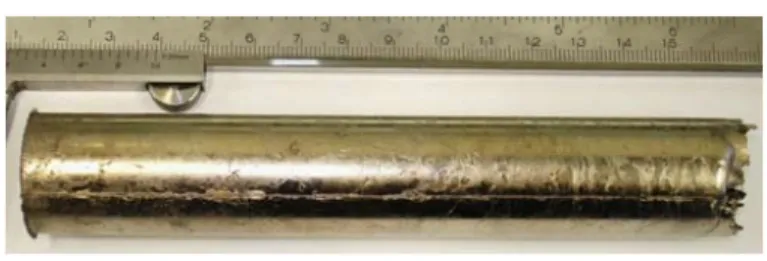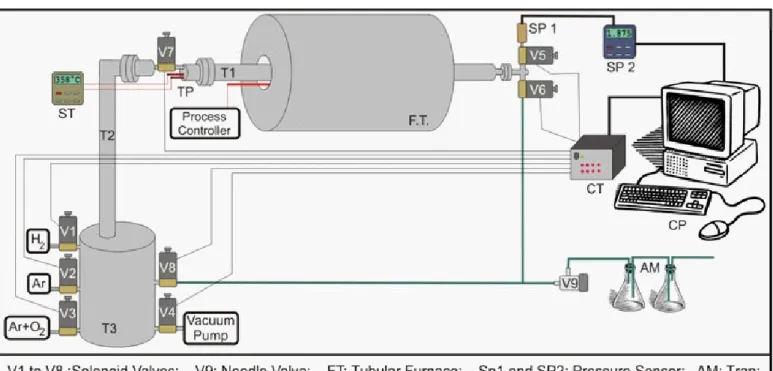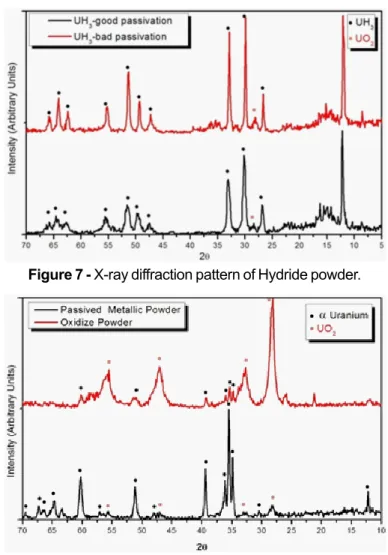Artigos científicos /
Scientific articles
METHOD FOR PREPARATION OF UZRNb ALLOY
POWDER PASSIVATION
bruno Moreira de Aguiar
1, Cláudia Terezinha Kniess
1,
Wilmar barbosa Ferraz
2, Humberto Gracher Riella
31 Instituto de Pesquisas Energéticas e Nucleares - IPEN
Av. Lineu Prestes, 2242 - São Paulo - SP bmaguiar@ipen.br
2 Centro de Desenvolvimento da Tecnologia Nuclear - CDTN\CNEN 3 Universidade Federal de Santa Catarina - UFSC
Abstract
The high density U-Zr-Nb uranium-based alloy is very promising to be used as a nuclear fuel not only in research reactors of low enrichment uranium but also in thermal power pressurized water reactors (PWR). This alloy needs to be processed into a powder to be useful in attainment metallic fuel plate fabrication. There are different methods to obtain powder from nuclear metallic alloy. In this study the hydriding-dehydriding method was chosen due to its rela-tive simplicity and low cost fabrication. However, uranium powder is notably pyrophoric and moreover, the uranium powder in hydride form is more dangerous because of the hydrogen liberation during the burning, increasing the risk of an accident or an explosion. In this way, the U-Zr-Nb hydrided and dehydrided powders need to be passivated before its exposition to the air. The passivation is the spontaneous formation of a hard non-reactive surface film that inhibits further corrosion. This layer is usually an oxide that is a few atoms thick. In this paper the UZrNb alloy was hydrided, dehydrided and then passivated in a Sievert type apparatus. Several process for determining the passiva-tion condipassiva-tions were tested at times varying between 2 and 24 hours at room temperature. For these treatments a mixture of gases of 90% Ar with 10% O2, pressurized in the range of 0.01 to 0.5 Bar was used. The obtained U-Zr-Nb passivated powders during different thermal treatments were characterized in terms of optical microscopy, scanning electronic microscopy, X-ray diffraction and then the results were discussed. All tests showed that the powders were of angular and irregular morphology.
Keywords: U-Zr-Nb Alloy, Hydriding-Dehydriding Method, Passivation.
1. Introduction
A necessary and important step in the plate type dispersion fuel fabrication is to obtain the alloy powder containing fissile material. However, the UZrNb alloy is very ductile and, therefore, difficult to be comminuted (1-3). In this work it was chosen the hydriding-dehydring method to obtain the UZrNb alloy powder.
One the main concerns that should be considered to obtain the powder of the uranium alloys is due to its high pyrophoricity. As its autoignition temperature is below room temperature the UZrNb alloy can ignite spontaneously. The burning of the hydrided or dehydrided powders is exo-thermic. Particularly, in the case of uranium hydride, the reaction is still more dangerous due to the liberation of the hydrogen, increasing more the flammability of this mate-rial (4-5). Therefore, the hydrided and dehydrided UZrNb powders need to be passivated before its exposition to the air. The passivation is the spontaneous formation of a hard non-reactive surface film that inhibits further corrosion (6). This layer is usually an oxide that is a few atoms thick.
Another important point that affects the pyrophoric-ity of uranium hydride powder and uranium metallic powder is its high surface area. Consequently, they have a high surface area exposed to an oxidizing atmosphere making them more prone to heat and ignite spontaneously.
In this work it is described the development process of the passivation of UZrNb alloy powder, powdered by the hydriding-dehydriding process to be utilized as a dispersion in a metallic matrix in the fuel plate fabrication.
2. Experimental Procedure
Initially, the UZrNb metallic alloy was obtained by the melting of metallic pieces of U, Zr and Nb. The melting of these elements was made in induction furnace using a graphite crucible, under argon atmosphere, in the tempera-ture range of approximately 1200 – 1500°C. Figure 1 shows a U-Zr-Nb ingot. Further, the ingot was cut in samples with thickness of approximately 2mm and whose mass is ap-proximately 3 grams each. After that, various
hydriding-de-hydring experiments with loads of approximately 9 grams of the alloy were obtained.
Figure 1 - Ingot of the UZrNb alloy.
Table 1 shows a semi quantitative chemical analy-sis for U-7.5Nb-2.5Zr alloy. The proportion of niobium and zirconium shown in this table is coherent with the nominal composition of this alloy.
Table 1 - Chemical analysis of U-7.5Nb-2.5Zr
Comminution of the alloy, through the hydrading-dehydrading and passivation steps were obtained employing the volumetric method with the Sievert-type apparatus. This equipment was totally developed and constructed at CDTN and is shown in Figure 2. This equipment is able to reach high temperatures (approximately 1100°C), to obtain a vacuum higher than 10-5 Torr and to support pressures of 7 Bar.
Analyte
Concentration (ug/g)
Li
1.461
Na
100.203
Mg
27.385
Al
1058.613
Ti
18.194
Mn
216.063
Ni
247.608
Cu
77.356
Sr
4.397
Zr
32076.837
Nb
88969.661
Ag
82.103
I
78.476
Hf
17.109
Ta
57.362
Pb
25.287
Th
63.124
The equipment was completely automated through the use of a software also developed at CDTN. The accessories used for the automation and data storage of the system are:
Digital manometer (SP1 and SP2):
• Measure the pres-sure inside tube T1 and send the data to the computer. The precision of the equipment is +0.002 Bar.
Valves controller (CT):
• Open and close the solenoid valves in accordance with the signals sent by the computer.
Computer / Program (CP):
• Responsible for the control, calculation and data storage of all the process. For this, a software was developed and it is responsible for the read-ing of the digital manometer and the thermocouples, data storage and process control.
Solenoid valves (V1 to V8):
• Valves responsible for the entrance and exit of gas/vaccum in the system. Valve V1 is connected to a hydrogen cylinder, V2 in the argon cylinder, V3 in the cylinder having the mixture of 90%Ar+10%O2, V4 in the vacuum pumps, V5 in the pressure sensor; V6 and V8 are used for the exit of gases of the system and V7 to join T1 with T2 and T3.
Vacuum central:
• Composed of mechanic and diffu-sion bombs.
Thermocouple (TP1-3):
• TP1 measures the temperature of the gas inside the T1; TP2 measures the sample
tem-perature and TP3 measures the temtem-perature of the tu-bular furnace.
Tubular furnace (FT):
• Tubular furnace with Pt-Rh heating element .
Temperature sensor:
• Measures simultaneously the gas temperature inside T1 (with the thermocouple TP1) and the sample temperature with the TP2 thermocouple dur-ing all the process.
For the effective control and temperature data acqui-sition of the hydriding-dehydriding and passivation processes it was constructed a sample holder having two thermocouples which are able to measure temperatures of the sample and of the gas around the sample. (Figure 3). This procedure is im-portant not only to control these processes, but also to monitor with effectiveness an eventual temperature excursion during the passivation step. This can result in loss of the process con-trol of passivation and, therefore, burns the material.
Figure 3 – Sample holder Figure 2 - Assembly drawing of the hydriding equipment.
Previously the accomplishment of the hydriding, the samples was thermally treated to obtain the necessary phases. The thermal treatment basically was made in two steps: 1000°C during some hours (in vacuum) for homo-genization followed by a decomposition of gamma phase into γ+α phases in a temperature range between 650°C to 300°C, followed by quenching in water.
The samples were hydrided at 150oC, under hydrogen atmosphere with approximately 1.85 Bar of pressure during one hour. A soon as the hydriding is com-plete, the hydrogen was substituted by a argon flux. The final pressure of argon in the system was about 2 Bar. After the gas change, the system was cooled until the temperature inferior of 30ºC.
At the beginning of the passivation, the system pressure was lowered to 0.006 Bar opening the valves V6 and V7, closing the V6 valve at the end of this step. Subsequently V3 valve opens during 0.1 second making a entrance of a small quantity of the gas mixture (90% Ar + 10% O2) in the system. Thereafter, the computer of the apparatus is programmed to wait 4 minutes and opens V3 valve again during 0.1 second. Repeating this procedure (open the valve and wait four minutes) several times makes the pressure inside the equipment to increase very slowly. After the pressure reaches 0.08 Bar (usually, it takes one and a half hours), V6 valve is opened, making the pressure fall again to 0.006 Bar. This process is repeated 10 times, making the percentage of oxygen inside the equipment in-crease gradually. It takes, usually, more than 15 hours to be fulfilled. Figure 4 shows the variation of pressure in function of the time inside T1 tube.
Figure 4 - Variation of pressure during the passivation process.
After the hydride passivation, the sample was remo-ved from the furnace and milled. The milling is a critical part of the process because the sample can be ignited easily in this moment. To avoid this problem, the samples were milled inside a glove box filled with argon. In this way, the hydride was slowly comminuted in an agate mortar with a pestle. For secu-rity, the hydride was divided into 3 amounts to avoid, in case of burning, the lost all the experiment. After each grinding, the sample was left in rest inside the glove box for some minutes. Figure 5 shows the hydride before milling.
Figure 5 - Hydride before milling.
Part of the milled sample was reserved for posterior tests(about 2 grams) and the remaining portion was placed in the equipment for dehydriding. This dehydriding step was made under vacuum at temperature of 400oC during 1 hour to obtain the metallic powder (2UHз→2U+3H2). After to obtain
the metallic powder, the system, under vacuum, was filled with argon under pressure of 1.9 Bar and the system was cooled to a temperature lower than 30ºC. After the sample has cooled, the passivation process of the metallic powder was repeated in an identical way of the hydride.
3. Results and Discussion
In this work, many powdered samples of the UZrNb alloy were obtained. The development of this procedure to car-ry out the passivation was possible after the accomplishment of various tests until a stable sample is reached. These tests have allowed to determine the exact rate and time to introdu-ce the oxygen in the chamber to passivate the sample.
There-fore, the determined time interval that the valve remains open was 0.1 s, the interval time between two openings of the ad-mission valve was 4 minutes and the numbers of times that the process repeats was 10 times. It is important to say that these determined parametric values are specific for the characteris-tics of the developed equipment, mainly due to the dimension of their chambers and to the amount of the sample. The ob-tained results have allowed to evidence that the developed passivation procedure is very well reproducible; however it is a qualitative process. Differently of our research of hydriding of the same alloy, when we found that it was possible to deter-mine with precision the amount of absorbed hydrogen, in the present work it was verified that it is not possible to determine the amount of absorbed oxygen to passivate the alloy.
The first evidence of a good passivation process was the color of the sample. The hydride, after a good passivation pro-cesses, has is brown. On other hand, oxidized sample shows a dark color. Figure 6 shows two photos comparing two samples obtained during the developing of the process of passivation. The photo on the left shows a partially oxidized sample and the picture on the right shows a well-passivated sample.
Figure 6 - Sample partially oxided (right) and a well-passivated sample (left).
The efficacy of the passivation process was verified by X-ray diffraction. With this technique, is possible to determi-nate the amount of formed oxide. Figure 7 shows the X-ray diffraction pattern of a well-passivated hydride powder and a partially oxidized hydride powder. The result of diffraction has shown that the well-passivated sample was oxidized in a lower amount than inferior to 3% and the other sample is basically uranium dioxide. Figure 8 shows the X-ray diffraction pattern of a well-passivated metallic powder and a partially oxidized uranium metallic powder.
Figure 7 - X-ray diffraction pattern of Hydride powder.
Figure 8 - X-ray diffraction pattern of mettalic powder. Figure 9 shows a SEM micrography of a dehydrided sample (uranium metallic powder). It could be verified that the obtained powder have an angular and irregular morphology.
4. Conclusion
In the present work, it was describe the development of passivation process for UZrNb alloy powder, powdered by the hydriding-dehydriding process. For this process, a Sievert type apparatus and software was developed. The samples and passivation accuracy was characterized by X-Ray diffrac-tion and Scanning Electron Microscope.
5. bibliographical References
Clark, C. R. and Meyer, M. K. Fuel Powder Production from 1.
Ductile Uranium Alloys. Proceedings of the 2002 Internatio-nal Meeting on Reduced Enrichment for Research and Test Reactors, October, 18-23, 1998, São Paulo, Brazil; 1998. Balart, S. N.
2. et al U-Mo powder obtained by a hydride-dehydride process. Proceedings of the 2000 International Meeting on Reduced Enrichment for Research and Test Reactors, Las Vegas, Nevada, October 1-6; 2000. Pasqualini, E. E.
3. et al Powder production of U-Mo alloy, Hydriding-Milling-Dehydriding process. Proceedings of RRFM, March, 17-20; 2002.
Weber, W. C. Progress on Dispersion Elements. New 4.
York, General Electric Company, Knolls Atomic Power Laboratory, Schenectady; 1958.
Stetskiy, Y. A; Trifonov, Y. I; Mitrofanov, A. V and Samarin, 5.
V. I. Manufacturing and investigation of LEU U-Mo fuel granules by hydride-dehydride processing. Proceedings of the 2002 International Meeting on Reduced Enrich-ment for Research and Test Reactors, November, 3-8, 2002Bariloche, Argentina; 2002.
Shuai, Maobin
6. et al. Hydrogen absorption-desorption properties of UZr0,29 alloy. Journal of Nuclear Materials, 301, 203-209; 2002.



